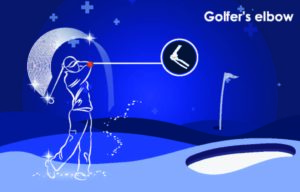Most of us have heard of “Tennis Elbow” and some of us have experienced it, but did you know that there is also a “Golfer’s Elbow”? Both of these are associated with overuse of the tendons and ligaments of the elbow joint, and involve different force patterns associated with each sport. In fact, many activities besides sports lead to overuse patterns that can lead to strain and injury of the tendons and ligaments. Strain patterns can be associated with computer keyboard use, thumb and finger overuse while typing on a modern cell phone, sports and many other activities.
How Do You Get Golfer’s Elbow?
The body is designed to respond to stress and strain of the connective tissues and repair itself despite the daily activities that we choose to pursue. As we age the repair processes are not as robust and ultimately have trouble keeping up with the daily microscopic injuries. Some activities, such as tennis and golf, are so repetitive that the repair processes cannot completely repair the damage with similar motions for several hours, several days per week. This leads to degeneration of the tendons and ligaments and this is the main source of most forms of joint and spine pain.
Golfer’s elbow often affects people who generally don’t use their forearm muscles much, and then suddenly use them a lot. The symptoms may appear after short-term overuse, but also after long-term frequent repetitive use. The possible causes include the following:
- Sports such as golf, weightlifting or “throwing sports” (e.g. javelin, shot put, baseball, softball)
- Manual work such as painting, hammering, repairing cars and chopping wood
- Working at a computer
- Cooking (e.g. chopping or peeling)
So although golfer’s elbow may in fact come from playing golf, in most cases it has nothing to do with this sport.
In the past, people thought that the symptoms were caused by an inflammation in the muscles. That turned out to be wrong, though. Nowadays it’s thought that something else plays an important role: Golfer’s elbow probably arises from the overuse or incorrect use of muscles, which leads to small injuries and wear-and-tear at the base of the tendons that attach to the muscles. https://www.ncbi.nlm.nih.gov/books/NBK507002/#:~:text=Less%20than%201%25%20of%20the,equally%20likely%20to%20get%20it.

Many of these injuries occur because people enjoy the sports that they pursue, so stopping the sport for weeks or months is not a very satisfying approach, nor is there a lot of confidence in years of studies that the repair process will then be fully satisfactory. In fact, current evidence suggests that the old adage suggesting that you “take some time off and give it a chance to heal” is usually not fully helpful.
The stimulus that your body’s tissues need to “get going” and heal the injuries fades with time, typically over 6-12 weeks. If your body does not heal within that time course, the residual damage will not typically heal further. Waiting for time to heal your painful injuries is usually not very satisfactory.
How Can You Heal Golfer’s Elbow?
Management for injuries like Golfer’s Elbow includes adjusting the grip and golf swing through physical therapy and golf-specific sport training. Learning to change bad habits can be very helpful. Learning to warm-up properly, stretch correctly, evaluate your golf clubs for proper length and club head angles, and addressing your whole body motion often helps reduce repetitive motion injuries.
Finding “weak links” using evaluation and treatment techniques such as Neurac / Red Cord therapy can help to isolate the source of your injuries. Correcting these motions can be very helpful.

If the joint, tendon and ligament injuries and persistent pain are a problem, Regenerative Medicine injections using Platelet Rich Plasma (PRP) or Bone Marrow Concentrate (BMAC) injection of your own Stem Cells and growth factors may be very helpful. These advanced healing techniques are actually available in an office-based clinic which can be performed in 1-2 hours, without the cost associated with hospitalization and without the risk and cost of surgery.
There are very few medical practitioners who specialize in these techniques and who have extensive experience in this advanced form of treatment. The providers at CHARM have been offering these techniques for over 20 years and that experience counts. Using advanced visualization including Live X-Ray and ultrasound helps to identify and isolate the painful structures. Recognizing the painful patterns that we have seen over many years provides insight and a comprehensive, guided approach that is focussed on your specific treatment needs.
Injured and degenerative joints, tendons and ligaments is the cause of most sports-related and life-limiting functional pain, and regenerative treatments using your own body’s growth factors is often the answer to these challenges. Learn more by contacting the Physical Therapy and Regenerative Medicine providers at CHARM.





